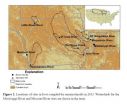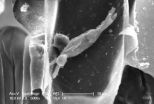(Press-News.org) BOSTON -- A new study has shown that it is possible to predict long-term cancer risk from a chemical exposure by measuring the short-term effects of that same exposure. The findings, which currently appear in the journal PLOS ONE, will make it possible to develop simpler and cheaper tests to screen chemicals for their potential cancer causing risk.
Despite an overall decrease in incidence of and mortality from cancer, about 40 percent of Americans will be diagnosed with the disease in their lifetime, and around 20 percent will die of it. Currently fewer than two percent of the chemicals on the market have been tested for their ability to induce cancer.
Using an experimental model, researchers from Boston University School of Medicine (BUSM), Boston University School of Public Health, the BU Bioinformatics Program and the National Toxicology Program at the National Institute of Environmental Health measured the effects on healthy tissue from few days of exposure to a given chemical and assessed the effects on the gene expression response in the liver. "By comparing the responses to known chemical carcinogens and non-carcinogens, we were able to extract a "signature" and an associated predictive model capable of discriminating with high accuracy between the two," explained corresponding author Stefano Monti, PhD, associate professor of medicine at BUSM and a member of the BU Superfund Research Program. "Furthermore, by inspection of the coordinated set of genes driving the response to chemical exposure, we were able to zoom in to the potential mechanisms driving cancer induction," he added.
According to the researchers there is growing recognition that the role played by environmental pollutants in human cancer is under-studied and that more formal approaches to the analysis of the biological consequences of prolonged exposure to pollutants are needed. "This work has confirmed that it is possible to predict the long-term cancer risk by measuring the short term effects," said Monti. "As a result of our findings we expect that accurate and cost-effective screening for evaluating the carcinogenic potential of the more than the 80,000 chemicals currently in commercial use soon will be a reality."
INFORMATION:
This work was partially supported by the NIH-funded Boston University Superfund Research Program, the Evans Center for Interdisciplinary Biomedical Research ARC on "Computational Genomic Models of Environmental Chemical Carcinogenicity" at Boston University, the National Center for Advancing Translational Sciences, National Institutes of Health, through BU-CTSI Grant Number UL1 TR000157, and the Art BeCAUSE Breast Cancer Foundation.
Researchers discover new way to determine cancer risk of chemicals
2014-07-25
ELSE PRESS RELEASES FROM THIS DATE:
Less than 1 percent of UK public research funding spent on antibiotic research in past 5 years
2014-07-25
Less than 1% of research funding awarded by public and charitable bodies to UK researchers in 2008 was awarded for research on antibiotics, according to new research published in The Lancet Infectious Diseases.
The study, which is the first detailed assessment of public and charitable funding to UK researchers focusing on bacteriology and antibiotic research, suggests that present levels of funding for antibiotic research in the UK are inadequate, and will need to be urgently increased if the growing crisis of antibiotic resistance is to be tackled effectively by UK ...
Synchronization of North Atlantic, North Pacific preceded abrupt warming, end of ice age
2014-07-25
CORVALLIS, Ore. -- Scientists have long been concerned that global warming may push Earth's climate system across a "tipping point," where rapid melting of ice and further warming may become irreversible -- a hotly debated scenario with an unclear picture of what this point of no return may look like.
A newly published study by researchers at Oregon State University probed the geologic past to understand mechanisms of abrupt climate change. The study pinpoints the emergence of synchronized climate variability in the North Pacific Ocean and the North Atlantic Ocean a few ...
A world first: Researchers identify a treatment that prevents tumor metastasis
2014-07-25
Metastasis, the strategy adopted by tumor cells to transform into an aggressive form of cancer, are often associated with a gloomy prognosis. Managing to block the metastasis or, even better, prevent their formation would be a giant step towards the fight against cancer. Researchers at Université catholique de Louvain (Belgium) successfully performed this world first on models of human tumors in mice. The results of their study are published online on 24 July in the prestigious journal Cell Reports.
The work by Professor Pierre Sonveaux's team, at Université catholique ...
Noise pollution impacts fish species differently
2014-07-25
Acoustic disturbance has different effects on different species of fish, according to a new study from the Universities of Bristol and Exeter which tested fish anti-predator behaviour.
Three-spined sticklebacks responded sooner to a flying seagull predator model when exposed to additional noise, whereas no effects were observed in European minnows.
Lead author Dr Irene Voellmy of Bristol's School of Biological Sciences said: "Noise levels in many aquatic environments have increased substantially during the last few decades, often due to increased shipping traffic. ...
Four-billion-year-old chemistry in cells today
2014-07-25
Parts of the primordial soup in which life arose have been maintained in our cells today according to scientists at the University of East Anglia.
Research published today in the Journal of Biological Chemistry reveals how cells in plants, yeast and very likely also in animals still perform ancient reactions thought to have been responsible for the origin of life – some four billion years ago.
The primordial soup theory suggests that life began in a pond or ocean as a result of the combination of metals, gases from the atmosphere and some form of energy, such as a lightning ...
Corn and soy insecticides similar to nicotine found widespread in Midwest rivers -- USGS news
2014-07-25
Insecticides similar to nicotine, known as neonicotinoids, were found commonly in streams throughout the Midwest, according to a new USGS study. This is the first broad-scale investigation of neonicotinoid insecticides in the Midwestern United States and one of the first conducted within the United States.
Effective in killing a broad range of insect pests, use of neonicotinoid insecticides has dramatically increased over the last decade across the United States, particularly in the Midwest. The use of clothianidin, one of the chemicals studied, on corn in Iowa alone ...
Zerenex (ferric citrate) long-term Phase 3 study results published in JASN
2014-07-25
New York, NY - July 24, 2014 -- Keryx Biopharmaceuticals, Inc. (Nasdaq:KERX) (the "Company") announced the publication of results from the long-term, randomized, active control Phase 3 study of Zerenex (ferric citrate), the Company's investigational oral ferric iron-based phosphate binder, for the treatment of hyperphosphatemia in patients with end-stage renal disease (ESRD) on dialysis. The PERFECTED study (PhosphatE binding and iRon delivery with FErric CiTrate in EsrD) was published online today in the Journal of the American Society of Nephrology (JASN).
This Phase ...
New hope for powdery mildew resistant barley
2014-07-25
New research at the University of Adelaide has opened the way for the development of new lines of barley with resistance to powdery mildew.
In Australia, annual barley production is second only to wheat with 7-8 million tonnes a year. Powdery mildew is one of the most important diseases of barley.
Senior Research Scientist Dr Alan Little and team have discovered the composition of special growths on the cell walls of barley plants that block the penetration of the fungus into the leaf.
The research, by the ARC Centre of Excellence in Plant Cell Walls in the University's ...
NRG1 isoforms could be an effective therapeutic candidate to promote peripheral nerve regeneration
2014-07-25
Neuregulin 1 (NRG1) is a pleiotropic factor characterized by the existence of numerous isoforms arising from alternative splicing of exons that confer to the protein deeply different characteristics. NRG1 plays an important role for both the myelination occurring during development and the different phases occurring after injury in the peripheral nerve: axon degeneration, axon regrowth, remyelination and target reinnervation
Researchers at the University of Western Australia have discovered that the soluble NRG1 upregulation observed in Schwann cells immediately after ...
Assessment on self-care ability of children with spina bifda
2014-07-25
Spina bifda (SB) is a complex congenital central nervous system disease that is caused by the incomplete closing of the neural tubes during the embryonic phase. Many patients have varying degrees of spasticity, urinary and fecal incontinence and neurocognitive retardation. Such problems decrease the patients' functional independence and their quality of life. Researchers at Ankara Physical Medicine and Rehabilitation Education and Research Hospital, Turkey investigate the functional performance in children with SB, using the Pediatric Evaluation of Disability Inventory ...


